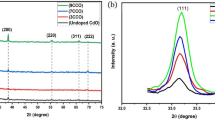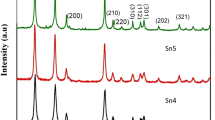Abstract
In the current study, the laser ablation technique (1 Hz repetition rate and a fixed pulse duration of 9 ns) has used to determine which crystal can produce silver nanoparticles (AgNPs). In gas sensing applications field, AgNPs could take place in the conventional and bulkier materials. Pulsed laser ablation in the liquid phase (PLAL) is one of the effective processes of creating NPs colloids that are stable over a long term even without organic agents. In the present study, the properties of AgNPs, which are produced through nano-second laser ablation in deionized water at 532 nm, 1064 nm, and 355 nm laser wavelengths, are compared. At 1 Hz repetition rate and a fixed pulse width of 9 ns, laser ablation was conducted. Using A p-type silicon wafer, porous silicon (PS) substrate has been created by electrochemical etching (ECE). The X-ray diffraction (XRD), transmission electron microscopy (TEM), and UV–Vis measurements have all been utilized in order to identify the AgNPs. This study demonstrated that the AgNPs, which were generated at 1064 nm and 532 nm, has the same size, with no discernible variations, while the size is different in the case of AgNPs at a wavelength of 355 nm a significant size difference can be seen. Moreover, it was concluded that the noble metal is more obviously impacted by the laser’s wavelengths, as well as, AgNPs have different crystalline forms at 532 nm, 355 nm, and 1064 nm, respectively. The recovery time, sensitivity, and reaction time regarding NO2 and NH3 gas sensors, which were built from prepared samples, have all been impacted by the change in the operation temperature. The maximum sensitivity was 34% in Ag-355/PS of NH3 gas 11.03 ppm and 24% of NO2 gas 20.26 ppm to each of the tested gases at ambient temperature. The results showed that AgNPs made by PLAL have improved their sensing properties, and Ag nanocolloidal synthesized at 355nm wavelength was displayed good sensitivity action to NH3 and NO2 gases.










Similar content being viewed by others

References
D. Jwied, U. Nayef, F. Mutlak, Synthesis of C: Se nanoparticles via laser ablated with magnetic field on porous silicon for gas sensor applications. Optik 242, 167207 (2021)
N. Harb, F. Mutlak, Gas sensing characteristics of WO3NPs sensors fabricated by pulsed laser deposition on PS n-type. J. Opt. 52, 323–331 (2023). https://doi.org/10.1007/s12596-022-00877-1
M. Aswad, F.A.-H. Mutlak, M. Jabir, S. Abdulridha, A. Ahmed, U. Nayef, Laser assisted hydrothermal synthesis of magnetic ferrite nanoparticles for biomedical applications. J. Phys. Conf. Ser. 1795, 012030 (2021)
M. Abed, F.A.-H. Mutlak, A. Ahmed, U. Nayef, S. Abdulridha, M. Jabir, Synthesis of Ag/Au (core/shell) nanoparticles by laser ablation in liquid and study of their toxicity on blood human components. J. Phys. Conf. Ser. 1795, 012013 (2021)
E.M. Sulaiman, F. Mutlak, U. Nayef, High-performance photodetector of Au–MgO/PS nanostructure manufactured via pulsed laser ablation technique. Opt. Quant. Electron 54, 744 (2022). https://doi.org/10.1007/s11082-022-04156-y
A.S. Alber, F.A.H. Mutlak, A novel laser-assisted approach for synthesis of AuNPs/PS nanostructures as photodetector. J. Opt. 42, 1–11 (2022). https://doi.org/10.1007/s12596-022-00958-1
Q.K. Hammad, A.N. Ayyash, F.A.H. Mutlak, Improving SERS substrates with Au/Ag-coated Si nanostructures generated by laser ablation synthesis in PVA. J. Opt. 69, 1–9 (2022). https://doi.org/10.1007/s12596-022-00971-4
E. Fazio, B. Gökce, A. De Giacomo, M. Meneghetti, G. Compagnini, M. Tommasini, F. Waag, A. Lucotti, C. Zanchi, P. Ossi, Nanoparticles engineering by pulsed laser ablation in liquids: concepts and applications. Nanomaterials 10, 2317 (2020)
M. Rafique, M.S. Rafique, U. Kalsoom, A. Afzal, S.H. Butt, A. Usman, Laser ablation synthesis of silver nanoparticles in water and dependence on laser nature. Opt. Quantum Electron. 51, 179 (2019)
N.G. Semaltianos, Nanoparticles by laser ablation. Crit. Rev. Solid State Mater. Sci. 35, 105–124 (2010)
D.S. Zhang, B. Göekce, S. Barcikowski, Laser synthesis and processing of colloids: fundamentals and applications. Chem. Rev. 117, 3990–4103 (2017)
R.M. Altuwirqi, A.S. Albakri, H. Al-Jawhari, E.A. Ganash, Green synthesis of copper oxide nanoparticles by pulsed laser ablation in spinach leaves extract. Optik 219, 165280 (2020)
T. Rashid, U. Nayef, M. Jabir, F.A.-H. Mutlak, Study of optical and morphological properties for Au-ZnO nanocomposite prepared by laser ablation in liquid. J. Phys. Conf. Ser. 1795, 012041 (2021)
F.A.-H. Mutlak, R. Jamal, A. Ahmed, Pulsed laser deposition of TiO2 nanostructures for verify the linear and non-linear optical characteristics. Iraqi J. Sci. 62(2), 517–525 (2021)
T. Rashid, U. Nayef, M. Jabir, F.A.-H. Mutlak, Synthesis and characterization of Au:ZnO (core:shell) nanoparticles via laser ablation. Optik 244, 167569 (2021)
J.W. Jeon, S. Yoon, H.W. Choi, J. Kim, D. Farson, S.H. Cho, The effect of laser pulse widths on laser—Ag nanoparticle interaction: femto-to nanosecond lasers. Appl. Sci. 8(1), 112 (2018)
M. Garcia, Surface plasmons in metallic nanoparticles: fundamentals and applications. J. Phys. D Appl. Phys. 45(38), 38950 (2012)
E. Giorgetti, A. Giusti, F. Giammanco, P. Marsili, S. Laza, Dendrimer-capped nanoparticles prepared by picosecond laser ablation in liquid environment. Molecules 14(9), 3731–3753 (2009)
A. Hamad, L. Li, Z. Liu, A comparison of the characteristics of nanosecond, picosecond and femtosecond lasers generated Ag, TiO2 and Au nanoparticles in deionised water. Appl. Phys. A 120(4), 1247–1260 (2015)
A. Schwenke, P. Wagener, S. Nolte, S. Barcikowski, Influence of processing time on nanoparticle generation during picosecondpulsed fundamental and second harmonic laser ablation of metals in tetrahydrofuran. Appl. Phys. A 104(1), 77–82 (2011)
F. Correard, K. Maximova, M.A. Estève, C. Villard, M. Roy, A. Al-Kattan, M. Sentis, M. Gingras, A.V. Kabashin, D. Braguer, Gold nanoparticles prepared by laser ablation in aqueous biocompatible solutions: assessment of safety and biological identity for nanomedicine applications. Int J. Nano Med. 9, 5415–5430 (2014)
J.S. Jeon, C.S. Yeh, Studies of silver nanoparticles by laser ablation method. J. Chin. Chem. Soc. 45(6), 721–726 (1998)
M. Chaja, T. Kramer, B. Neuenschwander, Influence of laser spot size and shape on ablation efficiency using ultrashort pulse laser system. Proc. CIRP 74, 300–304 (2018)
M.A. Al-Azawi, N. Bidin, A.K. Ali, K.I. Hassoon, M. Abdullah, Effect of liquid layer thickness on the ablation efficiency and the size-control of silver colloids prepared by pulsed laser ablation. Mod. Appl. Sci. 9(6), 20 (2015)
A. Menazea, M. Ahmed, Silver and copper oxide nanoparticles-decorated graphene oxide via pulsed laser ablation technique: preparation, characterization, and photoactivated antibacterial activity. Nano Struct. Nano Objects 22, 100464 (2020)
N. Harb, F.A.-H. Mutlak, Production and characterization of Tungsten Trioxide nanoparticles on porous silicon as photoconductive detector via pulsed laser deposition”. Optik 257, 168815 (2022)
A. Alber, F.A.-H. Mutlak, The role of various etching time in Si nanostructures for ultra-high sensitivity photodetector. Optik 265, 169427 (2022)
E.M. Sulaiman, U.M. Nayef, F.A.-H. Mutlak, Structural, Morphological, Photoluminescence, and sensitivity of Au:TiO2 nanoparticles via laser ablation on porous silicon”. J. Opt. 58, 1–7 (2022)
S. Khudiar, U. Nayef, F.A.-H. Mutlak, Preparation and characterization of ZnO nanoparticles via laser ablation for sensing NO2 gas. Optik 246, 167762 (2021)
D. Jwied, U. Nayef, F.A.-H. Mutlak, Synthesis of C: Se nanoparticles ablated on porous silicon for sensing NO2 and NH3 gases. Optik 241, 167013 (2021)
A. Ahmed, M.R. Abdulameer, M. Kadhim, F.A.-H. Mutlak, Plasma parameters of Au nano-particles ablated on porous silicon produced via Nd-YAG laser at 355 nm for sensing NH3 gas. Optik 249, 168260 (2022)
Funding
The authors declare that no funds, grants, or other support were received during the preparation of this manuscript.
Author information
Authors and Affiliations
Contributions
W.T.F. contributed to conceptualization, preparation samples, writing—original draft, visualization, investigation, analysis, validation, methodology, reviewing and editing.
Corresponding author
Ethics declarations
Competing interests
Authors would like to declare that they do not have any conflict of interests.
Additional information
Publisher's Note
Springer Nature remains neutral with regard to jurisdictional claims in published maps and institutional affiliations.
Rights and permissions
Springer Nature or its licensor (e.g. a society or other partner) holds exclusive rights to this article under a publishing agreement with the author(s) or other rightsholder(s); author self-archiving of the accepted manuscript version of this article is solely governed by the terms of such publishing agreement and applicable law.
About this article
Cite this article
Fzaa, W.T. Porous silicon modified as an ultrasensitive gas sensor via laser ablation. J Opt (2023). https://doi.org/10.1007/s12596-023-01371-y
Received:
Accepted:
Published:
DOI: https://doi.org/10.1007/s12596-023-01371-y



